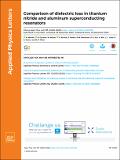Comparison of dielectric loss in titanium nitride and aluminum superconducting resonators
Author(s)
Melville, A; Calusine, G; Woods, W; Serniak, K; Golden, E; Niedzielski, BM; Kim, DK; Sevi, A; Yoder, JL; Dauler, EA; Oliver, WD; ... Show more Show less
DownloadPublished version (1.139Mb)
Publisher with Creative Commons License
Publisher with Creative Commons License
Creative Commons Attribution
Terms of use
Metadata
Show full item recordAbstract
© 2020 Author(s). Lossy dielectrics are a significant source of decoherence in superconducting quantum circuits. In this report, we model and compare the dielectric loss in bulk and interfacial dielectrics in titanium nitride (TiN) and aluminum (Al) superconducting coplanar waveguide resonators. We fabricate isotropically trenched resonators to produce a series of device geometries that accentuate a specific dielectric region's contribution to the resonator quality factor. While each dielectric region contributes significantly to loss in TiN devices, the metal-air interface dominates the loss in the Al devices. Furthermore, we evaluate the quality factor of each TiN resonator geometry with and without a post-process hydrofluoric etch and find that it reduced losses from the substrate-air interface, thereby improving the quality factor.
Date issued
2020Department
Lincoln Laboratory; Massachusetts Institute of Technology. Research Laboratory of Electronics; Massachusetts Institute of Technology. Department of Electrical Engineering and Computer ScienceJournal
Applied Physics Letters
Publisher
AIP Publishing